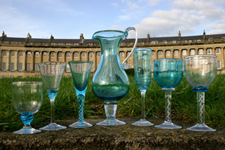Mrs. B’s The Art of Cookery gives us plenty of delicious recipes for brewing and made-wines. Raisin wine, Orange Wine, Elderberry Wine, Gooseberry Wine, Currant Wine, Cherry Wine, Birch Wine…for every native berry there seems to be a recipe to distill it into wine. Largely consisting of water and sugar, these wines would have made a festive and delicious treat for any table.
Hist-ro readers will be familiar with references to ratafia, a cordial flavoured with peach or cherry kernels, bitter almonds, or other fruits. It can also be made mixing unfermented grape juice and brandy.
Our debutantes often sip lemonade at balls, and we find in The House Servant’s directory (Robert Roberts, 1827) a delicious and common recipe for the drink invented in Paris originally in 1540s: “Take one gallon of water, put to it the juice of ten good lemons, and the zeasts of six of them likewise, then add to this one pound of sugar, and mix it well together, strain it through a fine strainer, and put it in ice to cool; this will be a most delicious and fine lemonade.”
Prinny was said to favour a strong punch consisting of strong green tea sweetened with sugar, champagne, lemons and water.
And aside from the staples of tea and chocolate (very dark…not at all like our modern hot coccoa), women could also sip on a delicious non-alcoholic Raspberry Shrub: ”
-
- 4 cups fresh Blackberries or Raspberries, about 16 ounces
- 2 cups cider vinegar
- 2 cups granulated sugar
- cold water
- ice
Place berries in a non-metal bowl or pitcher; add vinegar. Cover with plastic wrap or lid; refrigerate for 3 to 4 days. Strain mixture into a saucepan, pressing blackberries to extract all liquid. Discard solids then stir in sugar. Boil 2 to 3 minutes; remove from heat and let cool. Store in a tightly covered jar or pitcher. For each serving, combine 1/4 cup of the blackberry concentrate with 1 cup cold water; pour over ice in glasses.
Makes enough concentrate for about 12 servings.”
Most bartenders know that glassware can add or detract from a good drink. So what did the glassware most likely look like?










